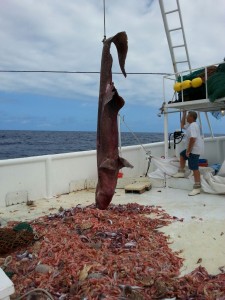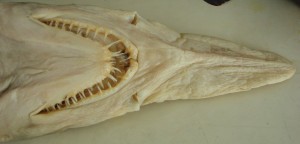Last week, commercial fisherman Carl Moore was fishing for royal red shrimp off the coast of Key West Florida. When he pulled up a net from more than 2,000 feet, Moore had caught something other than just shrimp. In his net was an unusual looking enormous fish—a goblin shark more than 18 feet long. As Moore reported to the NOAA scientist he reported his catch to, “it was uglier than a mother-in-law.”

This rare species of shark has only been seen in the Gulf of Mexico once before, in 2002. Though goblin sharks have been occasionally caught in the Atlantic and Indian ocean and a large group was caught in Taiwan following an undersea earthquake, most specimens have been found in the deep water canyons surrounding Japan. They are occasionally caught as bycatch in deep sea fisheries, as happened with Carl Moore. Unlike many species of shark, “they don’t have any commercial value, other than their jaws,” says Charlott Stenberg, a marine biologist and science writer. “But, I have a Japanese friend who ate some of it and thought the tongue was delicious”

Goblin sharks can be easily identified by their bizarre jaw, which protrudes a great deal while eating (video). The jaw of the goblin shark gives them their Japanese common name: Tenguzame, which references a mythical half human and half bird creature called Tengu. Their long, flat snout, relatively small head, and pink coloration are also distinctive. “ I love them because they’re pink, they’re mysterious, and they live deep among other cool creatures,” Stenberg says. I know many people think that they are ugly, but that just makes me love them more.”

“NOAA biologists encourage people to call and report these rare sightings and catches, as the information they can collect allows them to know more about a species,” according to the official statement about this goblin shark by the National Marine Fisheries Service, After taking the photographs shown above, Carl Moore quickly released the goblin shark, which swam away. This story spread without all of the correct information, initially resulting in several colleagues and I believing that Moore still had the shark and that it was possible to get samples for research projects. I am glad that this rare shark was released alive and reported to the proper authorities, and I will be writing a follow-up post soon explaining what to do if you catch a rare fish that does not survive. Such a specimen could benefit numerous ongoing research projects and help scientists to better understand a little-known animal.
Wow! This is a big deal! I knew what goblin sharks were before this and I knew that we didnt know much about them, but this is crazy! I didnt know we only saw one in 2000!
Wow, look at all the bycatch – young fish, squid, crabs, spiny lobster (?), not to mention the shark. What a ridiculously destructive fishery, remind me to never eat Royal Red Shrimp…
Well done for putting it back into the sea and not giving it to the scientists – hopefully these creatures that only a mother could love may increase in numbers. We do so much damage all around our planet – every little action helps.
Released alive? In the pictures it looks pretty dead.
I wasn’t there. The fisherman says it was released alive.